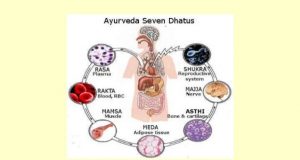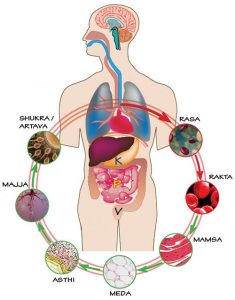SAPTADHATU – BODY ANATOMY|

According to Ayurveda , the human body is primarily made up of Saptadhatus.
“Saptadhatus” is a Sanskrit word, which means seven constituent elements (Sapta means seven and dhatus means tissues). These seven dhatus are responsible for the entire structure of the body. The dhatus maintain the functioning of different systems, organs and vital parts of the body and play a significant role in the development and nourishment of the body. In common terms, the seven types of Dhatus are plasma, blood, muscle, fat, bone, bone marrow and reproductive fluid. In Ayurveda, they are called Sapta Dhatus – Rasa, Rakta, Mamsa, Meda, Asthi, Majja and Sukhra respectively.
Each tissue or dhatu is primarily governed by one of the tridoshas – vata, pitta & kapha. When one dhatu is defective, it affects the successive dhatu, as each dhatu receives its nourishment from the dhatu preceding it. Let us know in detail about the dhatus:-
1) Rasa (Plasma) which is the first dhatu which contains nutrients & minerals from digested food and which nourishes & replenishes all the tissues and organs. This is made up of the water element.
2) Rakta (blood) which transports oxygen to all tissues and vital organs and maintains life. This is made up of fire element and fire is responsible to give strength to our body and mind.
3) Mamsa (muscle) which covers the delicate vital organs and enables movements of bones & joints and maintains the physical capacity and strength of the body. The earth element is responsible for the formation of this element. Consumption of nuts, beans, meat and legumes will boost the proper nourishment of this dhatu.
4) Meda (Fatty tissue) maintains the lubrication and oiliness of all the tissues. The excess storage of fat in the abdomen is because of this tissue.
5) Asthi (bones and Cartilage) gives support to the body structure.
6) Majja (bone marrow) fills up the bony spaces.
7) Shukra which are the reproductive tissues responsible for reproduction. Sperm in males and Ova in females.

Any disease where vata-pitta-kapha are involved, the vitiated doshas directly affect the dhatus. Taking the vitiated dosha in consideration, the cause of a diseased dhatu is accurately determined. The imbalanced or disrupted dosha and improper dhatus can always be a major cause of several kinds of diseases. Once the root cause of the illness is known, the corresponding treatments are used to balance the system by balancing the excess element(s) and increasing the deficient one(s). Balance of the dhatus can be maintained by keeping the doshas in balance through a proper diet, exercise and panchakarma.
To Know More Watch Our YouTube Video :- https://youtu.be/ePM45Zr1tSY
#saptadhatus #ayurveda #bodyanatomy #jyovis
– For Doctor Consultation :- http://bit.ly/2tomCT6
– Go Through All The Products :- www.jyovis.com/store
– Online Learn & Earn Courses :- www.jyovis.com/courses
– Best Ayurvedic Products :- http://bit.ly/36ntvmA
– Top Cosmetic & Beauty Products :- http://bit.ly/2F99OCW
– Active Forever 21 Days Online Program :- https://www.jyovis.com/product/active…
